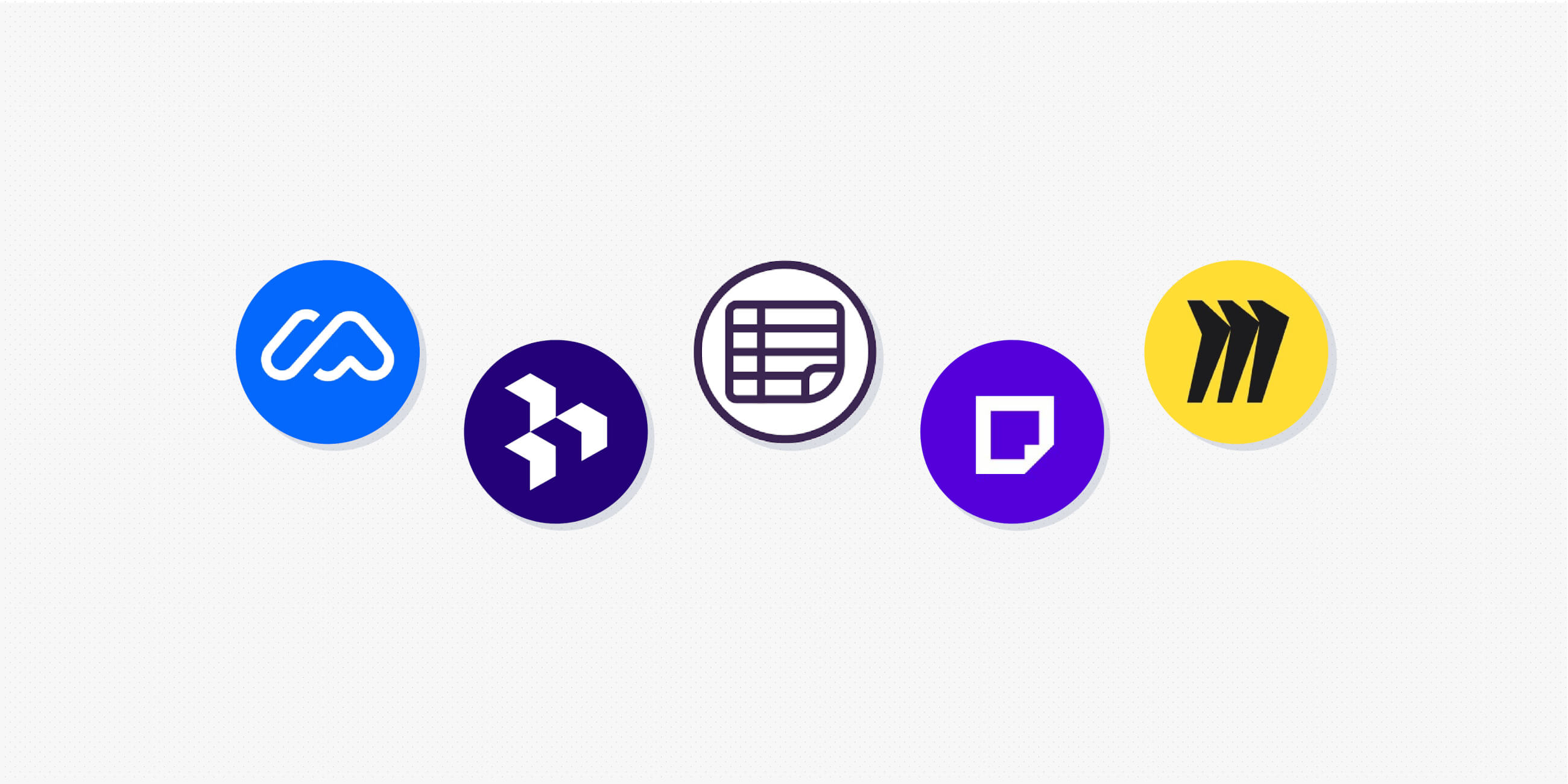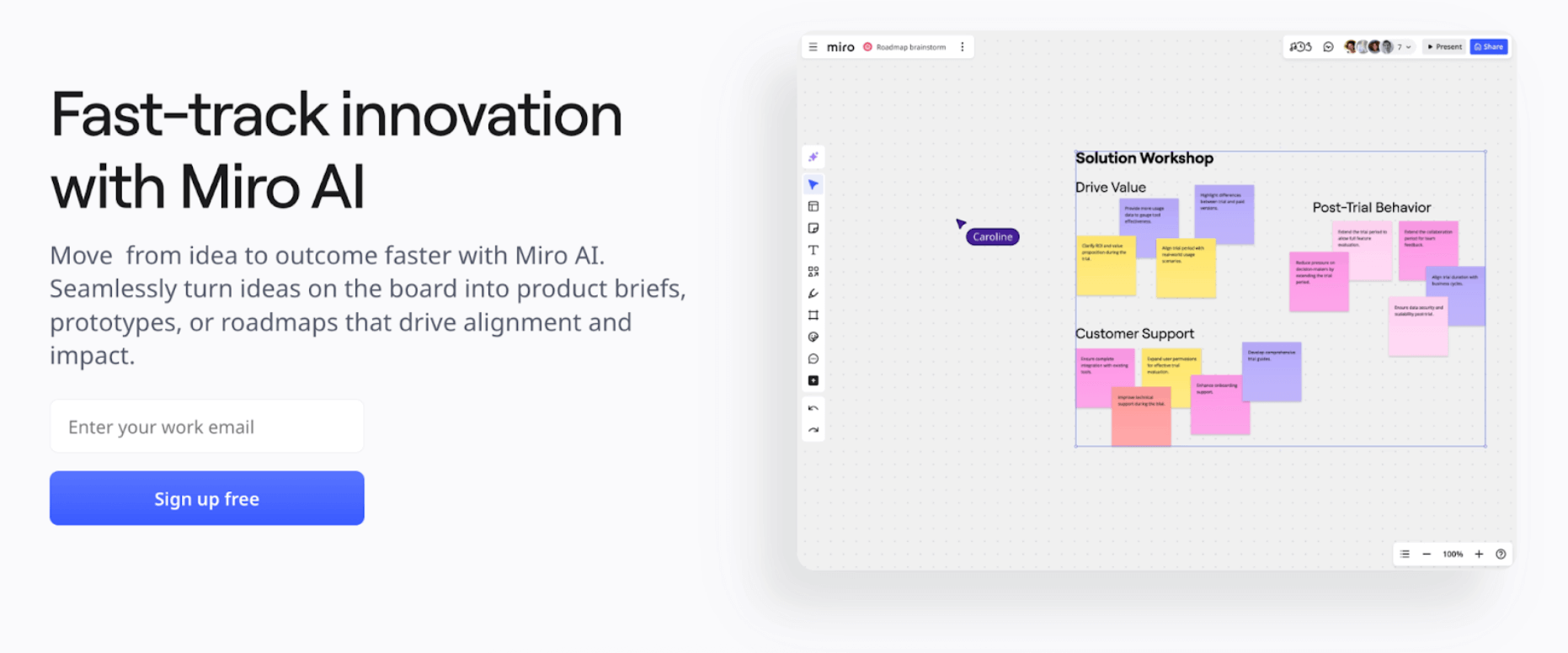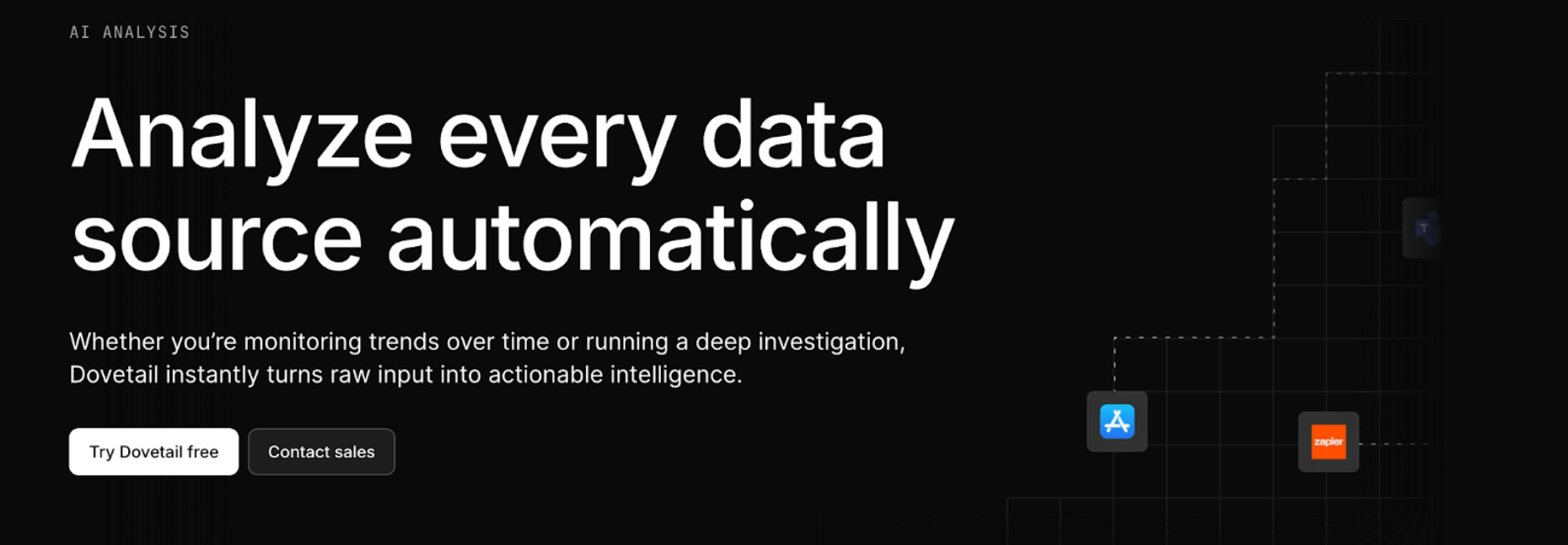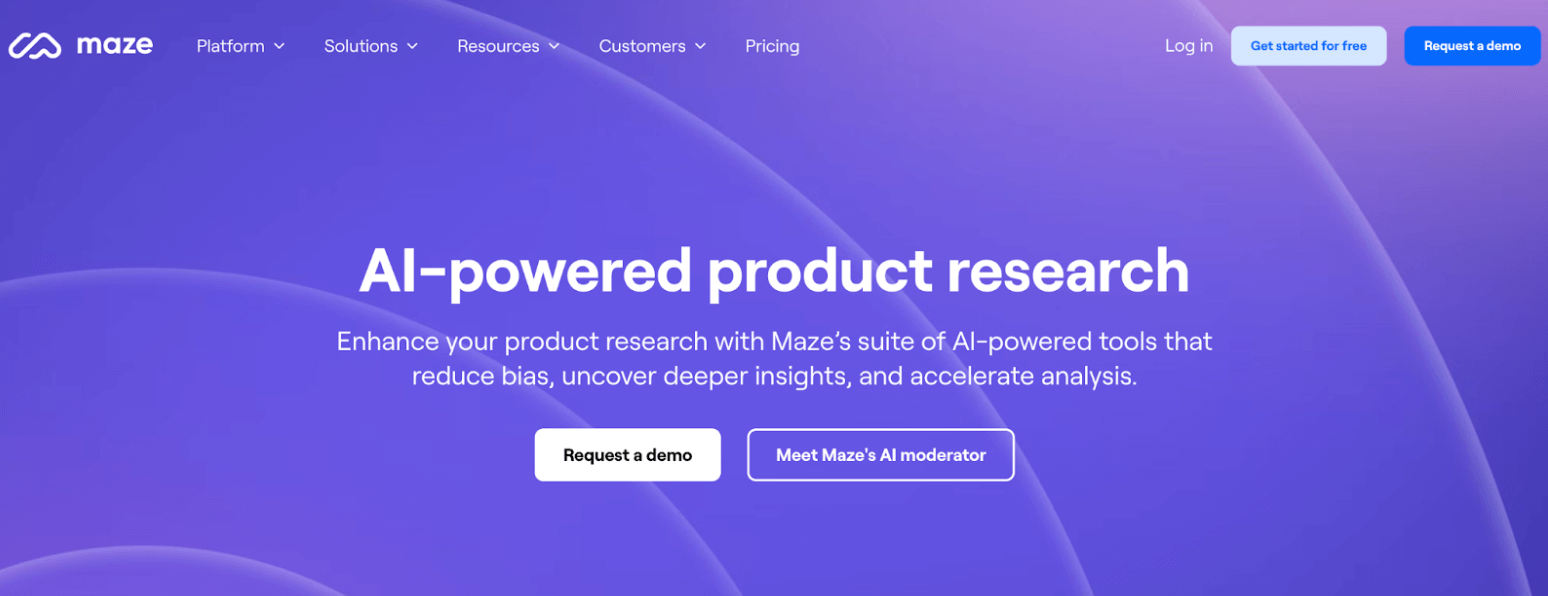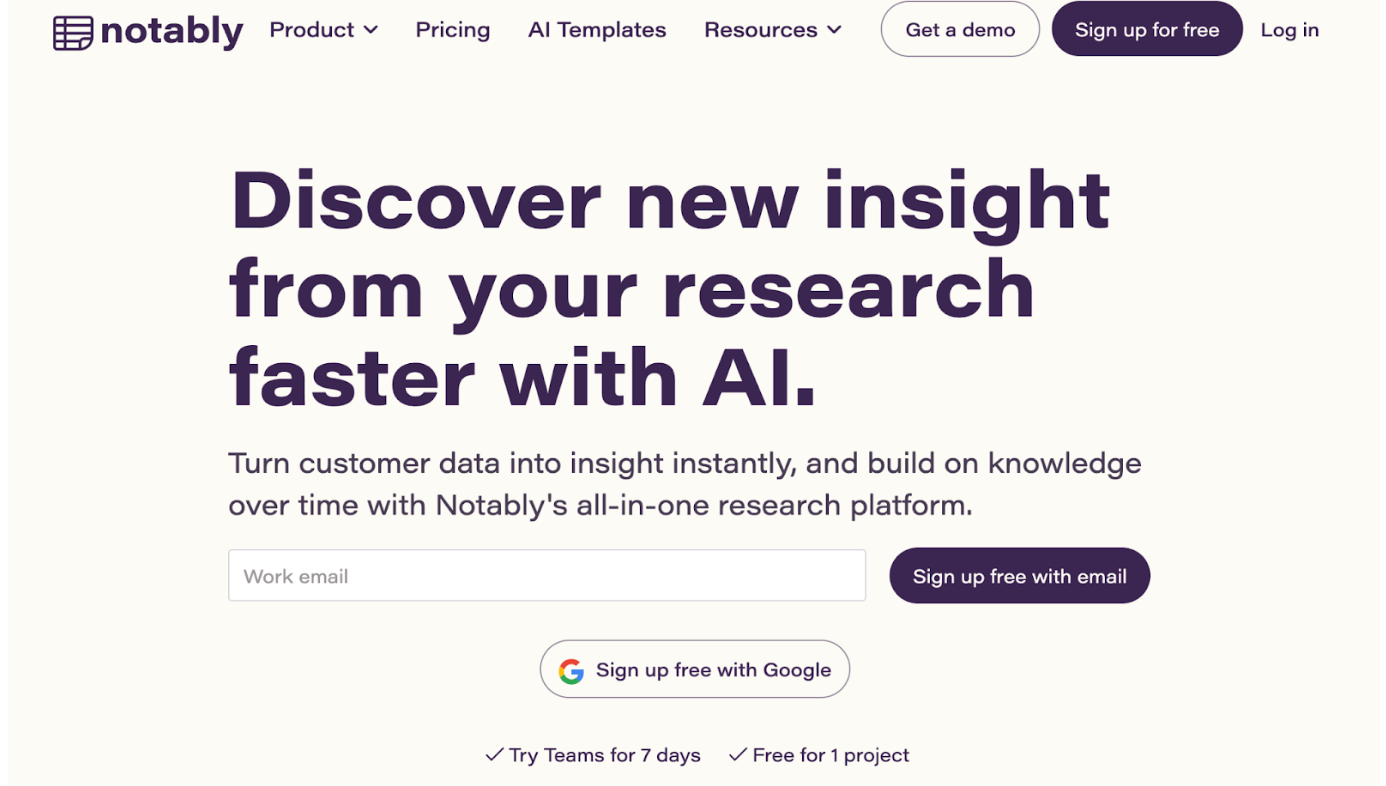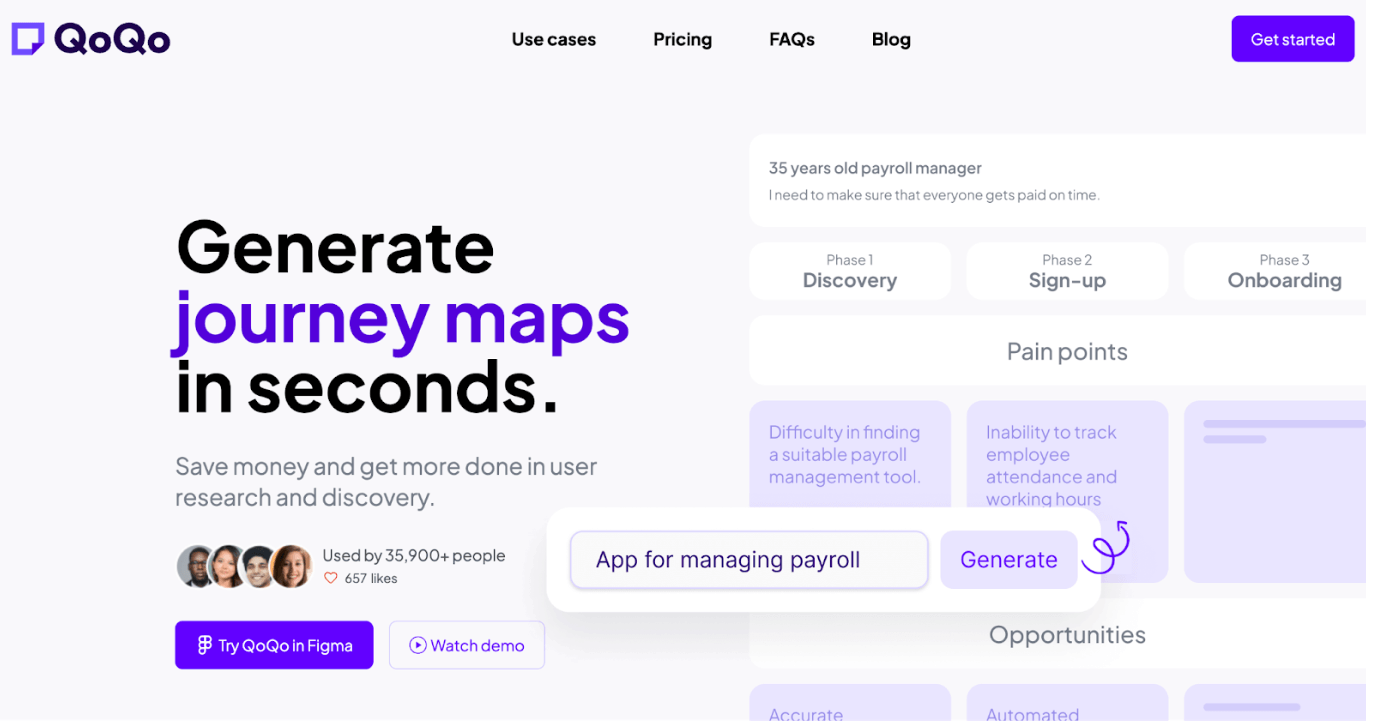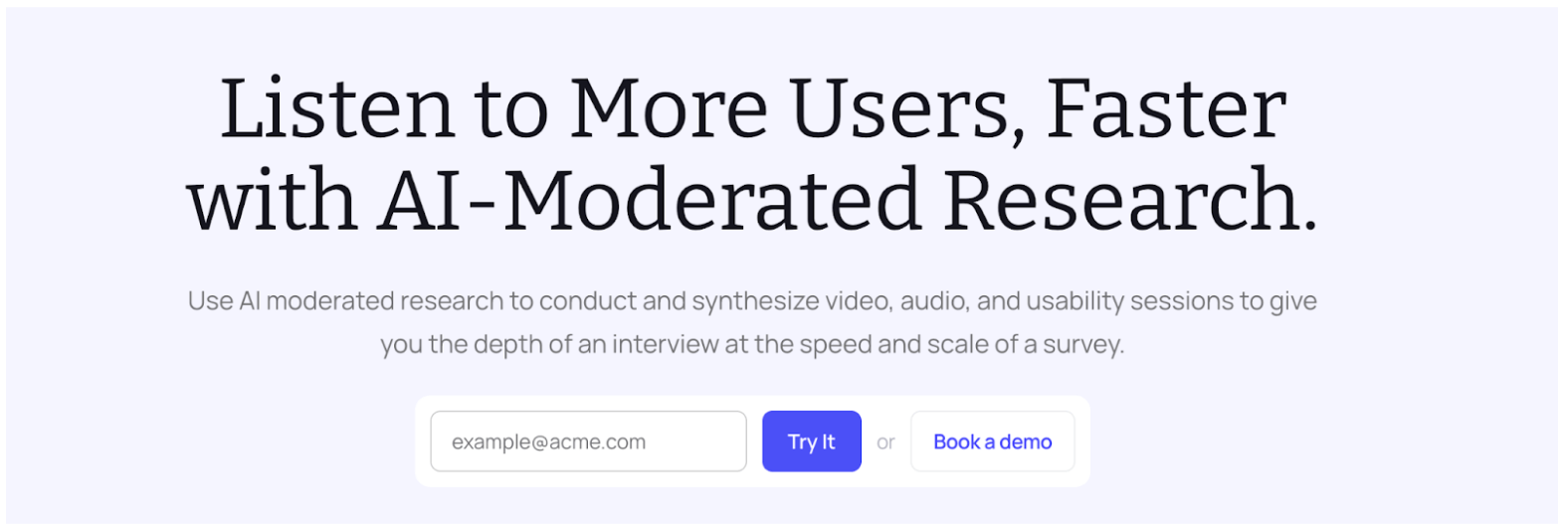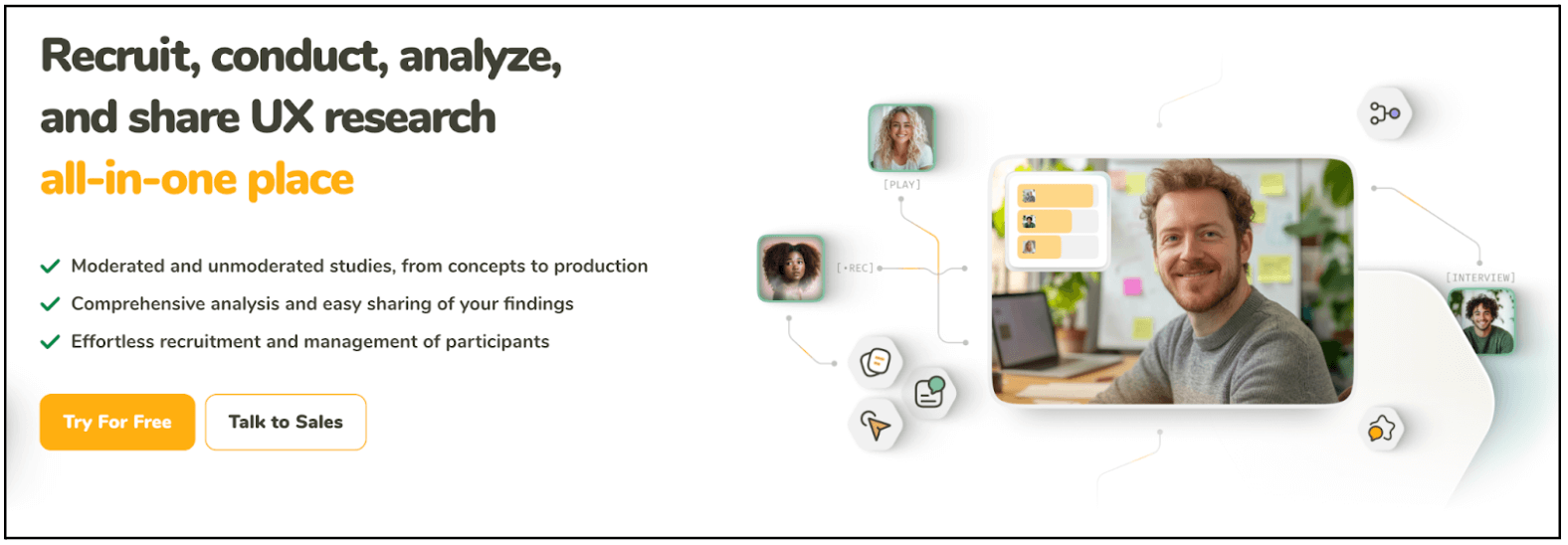User research is essential for good UX, but it can be time-consuming and resource-heavy. AI-powered tools help to make the process more efficient, getting you to those all-important insights a little faster.
So what are the best AI tools for user research and how can you use them for maximum impact?
Let’s take a look.
1. Miro AI
Miro AI at a glance:
- Price: You can access Miro AI with all Miro plans: Free, Starter (€8/member per month), Business (€16/member per month), and Enterprise (custom pricing).
- Used for: Quickly turning unstructured research data and ideas on your Miro boards into organised insights, summaries, and visuals with the help of AI.
- Learn more: Miro AI.
You’re no doubt familiar with Miro, one of the most popular UX design tools on the market. Now you can supercharge your user research efforts in Miro with the help of Miro AI.
Miro AI is integrated throughout the entire Miro platform. It uses advanced machine learning to understand the content on your board, whether it’s sticky notes, user quotes, or images and diagrams.
Why is this useful? Well, you can use it to quickly pull out key insights from your board, to condense and summarise information, and to generate new content such as presentations, action lists, and visualisations. Miro AI can save you hours of manual synthesis. Getting to the bottom of your research just got a whole lot easier!
How to use Miro AI for user research
Here are just a few of the ways Miro AI can help with user research:
- Summarise research data: Miro AI can analyse large clusters of sticky notes, comments, or transcripts and generate concise summaries or insight cards. This helps you quickly surface key findings and align on what matters most during synthesis or debrief sessions.
- Visualise ideas with AI-generated diagrams: Turn unstructured notes and ideas into organised, AI-powered mind maps, flowcharts, or diagrams. Miro AI helps transform complex research data into clear, easy-to-follow visuals that make patterns and relationships easier to understand.
- Smart clustering: When you’re dealing with large amounts of qualitative data, Miro AI can automatically group similar sticky notes or comments by theme, sentiment, or keyword. It’s an advanced form of affinity mapping that speeds up the process of identifying trends and building user insights.
- Generate personas and insight summaries: Go from raw data to structured outputs. Miro AI can create draft personas based on your research inputs, or generate summarised reports that capture key pain points, motivations, and opportunities for design.
Create presentations and deliverables: Once your analysis is done, Miro AI can turn your insights into ready-to-share presentations, outlines, or action plans, helping you move smoothly from research to next steps.
2. Dovetail
Dovetail at a glance:
- Price: Free plan which includes 1 project; Professional plan for $15/user per month; Enterprise plan with custom pricing. Dovetail also offers a 7-day free trial.
- Used for: Streamlining analysis and synthesis of qualitative research data.
- Learn more: Dovetail AI
Dovetail is a powerful user research and feedback analysis platform designed to help teams centralise, analyse, and share customer insights. Previously, Dovetail was primarily a research repository, but it’s now evolved into a fully AI-native insights hub, embedding artificial intelligence across its core features for faster, smarter, and more collaborative user research.
Dovetail now integrates AI directly into your workspace, eliminating much of the manual legwork that otherwise goes into research synthesis. You can auto-transcribe interviews, automatically cluster themes, summarise insights, and even query your data conversationally.
How to use Dovetail AI for user research
Here are some of the most useful AI features available in Dovetail:
- Automatic transcription and capture: Upload interview recordings, video calls, or audio files and Dovetail will automatically generate accurate transcripts with speaker detection. You can then highlight, tag, and extract key moments for analysis.
- AI-generated research summaries: Dovetail can instantly produce Magic Summaries and Insight Reports that condense lengthy transcripts, notes, or documents into clear, actionable overviews.
- Smart clustering and thematic analysis: With Magic Cluster, Dovetail automatically groups related highlights into coherent themes. The latest version includes advanced clustering powered by generative AI to surface deeper conceptual links and emerging patterns in your research.
- Sentiment analysis: Dovetail’s AI can analyse qualitative data to detect sentiment (positive, neutral, or negative) across interviews, survey feedback, or ongoing support data. This helps you track user attitudes, emotions, and pain points over time.
- Ask Dovetail (AI chat): The new Ask Dovetail feature lets you query your research data in natural language. For example, “What usability issues did participants mention most often?” The AI scans your workspace and returns summarised, cited insights.
- Automated insight cards: As you work through your research, Dovetail can automatically generate Insight Cards that capture key findings, supporting evidence, and user quotes, ready to be refined and shared with stakeholders.
- AI-driven clustering across channels: For continuous sources like support tickets or NPS responses, the Channels feature uses AI to automatically classify and theme feedback, helping you monitor ongoing trends and shifts in user sentiment.
- Translation and redaction (beta): Dovetail’s built-in translation lets you summarise or analyse multilingual data, while automatic redaction removes personal identifiers from transcripts and recordings (ideal for privacy-compliant research sharing).
- Recruit (beta): Currently in beta, Dovetail Recruit helps streamline participant management by allowing you to source, schedule, and track participants directly within your workspace.
3. Maze
Maze at a glance:
- Price: Free for individuals; $99 per month for the Starter plan; custom pricing for the Enterprise plan.
- Used for: End-to-end user research automation, from drafting better questions and conducting interviews with an AI moderator, to summarising transcripts, finding themes, and analysing sentiment.
- Learn more: Maze AI.
Maze is a firm favourite when it comes to user research tools, and it now comes equipped with a host of AI solutions to speed up your work. With Maze AI, you can enhance and automate many aspects of the research process, from crafting interview questions and automatically triggering dynamic follow-up questions to transcribing interviews, uncovering common trends, and analysing sentiment.
How to use Maze AI for user research
Here’s how you can incorporate Maze AI into your user research process:
- Fine-tune and edit interview questions: If you want to conduct effective user interviews and surveys, it’s important to ask the right questions. With Maze’s Perfect Question feature, you can leverage the power of AI to identify bias, grammatical errors, and readability issues in your research questions. The tool also offers suggestions for rephrasing your questions. This helps to ensure clarity and neutrality, which is essential if you want to gather reliable data.
- Auto-generate follow-up questions: Leverage AI to trigger contextual follow-up questions based on each participant’s unique responses. This enables researchers to delve deeper into user feedback and gain more nuanced insights.
- Run AI-moderated interviews at scale: Use Maze’s AI Moderator to conduct interviews autonomously, gathering responses in multiple time zones. You can literally run interviews while you sleep, no manual presence required.
- Generate themes: Maze’s AI can automatically identify and generate common themes in your open-ended question responses. No need to manually sift through the data to find meaningful patterns, let AI speed up your analysis.
- Transcribe interviews and recordings: Transcribing audio recordings into text is, without doubt, one of the most time-consuming aspects of conducting user research. Fortunately, Maze enables you to automate the process with AI, saving you considerable time (and energy).
- Conduct sentiment analysis: Speed up the process of analysing participant responses with AI-driven sentiment analysis. Maze AI can assign positive, negative, and neutral tags, enabling you to quickly understand your users’ sentiments, and, as a result, the quality of their user experience and overall satisfaction with your product.
- Generate automatic reports: Once the data’s in, Maze can produce AI Reports or Rapid Research Summaries, ready-made, shareable reports that distill findings, metrics, and narrative insight.
4. Notably
Notably at a glance:
- Price: $40 per month for the Pro plan (includes 50 AI credits); $300 per month for the Teams plan (includes 200 AI credits); custom pricing for the Enterprise plan (includes 400 AI credits).
- Used for: Summarising qualitative research data, conducting sentiment analysis, auto-clustering and tagging, generating insights and visuals, and creating AI-assisted journey maps and storyboards.
- Learn more: Notably AI.
Notably is an all-in-one user research platform powered by AI. It embeds AI across the entire qualitative research workflow, from transcription, tagging, clustering, and insight generation to richer outputs like journey maps, storyboards, templated insights, and visual reports. Notably helps you automate large parts of your workflow while enabling you to guide and refine the results.
How to use Notably AI for user research
Here’s how Notably can assist with user research:
- Generate concise debriefs from interviews: With Notably AI, you can instantly turn hours of interviews into digestible summaries. This enables you to quickly extract participant information, identify emerging patterns, and pull out interesting takeaways, streamlining the oft-messy process of analysing qualitative data.
- Conduct sentiment analysis: Get to the heart of how your research participants really feel with AI-powered sentiment analysis. Notably can instantly reveal positive and negative sentiments across your entire study, giving you a clear read on your users’ attitudes and emotions.
- Auto-highlight, tag, and cluster qualitative data: Notably learns how you tag data, then suggests tags and groups content automatically, improving over time for increasingly faster and more accurate analysis.
- Generate images: Create unique and meaningful visuals to represent your data with the help of Notably AI. Notably can generate images based on the content of your insights. Alternatively, you can describe your vision and let the AI create images based on your input. This is a great antidote to old-fashioned reports and overused stock images.
- AI templates and custom prompts: Notably offers a library of AI templates (e.g. for debriefs, personas, or journey mapping) and allows you to build custom prompt-based templates tailored to your workflow.
- AI-assisted journey mapping and storyboards: Notably now supports journey map-style clustering (i.e. mapping stages) and can generate AI storyboards based on your insights to visualise the user journey.
- Workflow automation with Posty tasks: Use Posty, Notably’s built-in AI research assistant, to automate various steps in your workflow. For example, when new interviews are added, you can set up your workflow so that they are automatically transcribed, highlighted, and tagged.
5. QoQo (Figma plugin)
QoQo at a glance:
- Price: $7 per month for 1 user and unlimited access.
- Used for: Accelerating early UX research and discovery processes: generating personas, journey maps, affinity diagrams, and research prompts right inside Figma, and surfacing insights from uploaded documents, all powered by AI.
- Learn more: QoQo.
QoQo is a Figma plugin powered by OpenAI’s GPT (the same technology behind ChatGPT). It functions as an AI companion for UX and product design, supporting many aspects of the research and ideation phases, from creating personas and journey maps to organising qualitative data, allowing you to prototype, explore, and iterate faster.
How to use QoQo for user research
Combined with Figma, QoQo is a powerful addition to your tool stack. You can use it to:
- Create user journey maps: User journey maps are a great tool for visualising how users interact with your product. With QoQo, you can speed up the process of creating journey maps, allowing you to quickly step into your users’ shoes and see things from their perspective.
- Create affinity diagrams: Affinity diagramming is a popular method for sorting through dense research data, but it can be time-consuming. QoQo accelerates the process, enabling you to organise your data in seconds. Simply drop in observations, quotes, or sticky-note content and let QoQo organise them into thematic clusters.
- Write interview scripts: If you want a faster approach to crafting interview questions, use QoQo to automatically generate scripts. Be sure to tweak them so they sound suitably human, though!
- Generate user personas: Based on your input, QoQo generates cards that you can use to create effective user personas. Bear in mind that all user personas should be based on user research, not on fictional qualities or assumptions.
- Upload and chat with documents: You can feed in PDFs or text documents (e.g. interview transcripts or research notes) and ask QoQo to summarise them or pull out key insights.
If you’d like to learn more about how to leverage AI in user research, consider the Professional Certificate in User Research which now includes a dedicated Certificate in AI Fundamentals. Across three live masterclasses, you’ll learn how to prompt effectively, how to conduct faster, more efficient research with AI, and how AI can support you with downstream design tasks such as generating UX copy or creating prototypes.
6. Looppanel
Looppanel at a glance
- Price: $30 per month for the Solo plan; $395 per month for the Pro plan; custom pricing for Enterprise plans. Looppanel also offers a 15-day free trial.
- Used for: Accelerating qualitative research workflows by transcribing, summarising, theming, tagging, and surfacing insights across interviews and customer feedback, all inside a unified research repository.
- Learn more: Looppanel
Looppanel is an AI-powered research assistant and repository that takes care of the heavy lifting in qualitative analysis. It automatically transcribes, summarises, and organises your research sessions so you can spend less time sorting through data and more time uncovering insights.
How to use Looppanel for user research
Here are some of the most useful AI-powered features available with Looppanel:
- Auto-tagging and theme detection: Looppanel’s AI analyses all your calls, notes, and documents together and suggests tags and themes. However, you’re in full control; you can edit, add, remove, or rename tags manually at any time.
- Repository search: Looppanel’s AI-powered search can look through all your notes and transcripts in the repository to find relevant data, in seconds. You don’t have to spend too much time on repository maintenance thanks to this feature, it works even if you don’t tag the data. With simple Google-like search for any term, concept, user quote, data point, or feature name, you can easily find all the notes and transcript text associated with it.
- AI-powered transcription: Looppanel can provide transcripts of call recordings in mere minutes, with over 95% accuracy. These AI-generated transcripts also highlight important sections and provide auto-generated summaries of each section, to make it easier to analyse. Currently the tool supports transcription in English and 8 other languages.
- Sentiment analysis: Looppanel’s transcription also features sentiment analysis, and identifies questions, positive and negative sentiments in transcripts. This makes it much easier to review data, and save recurring user issues, patterns and themes.
- Edit and traceability: Even though AI does a lot of the work, every tag, summary, and note remains traceable to its source. You can always dig into the original transcript or clip, and you can override AI’s suggestions.
7. Outset AI
Outset AI at a glance:
- Price: Subscription based (available on request).
- Used for: Conducting AI-moderated user interviews, concept testing, and usability studies.
- Learn more: Outset AI
By integrating AI into the research process, Outset frees you up to focus more on strategy and decision-making while the platform handles the repetitive tasks of data collection and initial analysis. Save time while scaling your user research efforts. Win-win!
How to use Outset AI for user research
Here’s how Outset AI can supercharge your user research:
- AI-moderated interviews: Conduct user interviews with AI moderation, allowing for consistent questioning and unbiased data collection.
- Real-time sentiment analysis: Analyse user emotions and sentiments during sessions to gauge reactions and identify areas of concern.
- Automated transcription and summaries: Convert audio responses into text and generate concise summaries for quick review.
- Generate highlight reels: Automatically create highlight reels from sessions to showcase key moments and insights.
- Cross-platform usability testing: Test prototypes across various devices and platforms to ensure a seamless user experience.
- Participant management: Manage participant recruitment, scheduling, and compensation directly within the platform.
- Data visualisation: Visualise research findings through intuitive dashboards and reports for easier interpretation and presentation.
8. UXTweak
UXTweak at a glance:
- Price: A limited free plan for solo users; €92/month for the Business plan (includes 1 user license, price increases with additional user licenses); custom pricing plans available.
- Used for: Running, managing, and analysing usability studies with built-in AI transcription, advanced analytics, and participant recruitment tools.
- Learn more: UXtweak.com
UXtweak is an all-in-one UX research platform that brings together everything you need to plan, run, and analyse studies, now with AI-powered transcription to streamline qualitative analysis.
It combines tools for website and prototype testing, session recording, card sorting, tree testing, and mobile testing, making it versatile enough to support nearly any research method. Beyond testing, it also helps with recruiting, scheduling, and managing participants, all in one place.
With its intuitive interface and AI-assisted capabilities, UXtweak reduces the manual workload of analysing qualitative data while helping you uncover meaningful insights faster. It’s a practical choice for teams looking to run user research at scale without juggling multiple tools.
How to use UXtweak AI for user research
Here’s how to make the most of UXTweak’s AI capabilities:
- AI-powered transcription: Automatically transcribe and timestamp your user interviews and moderated sessions, saving hours of manual note-taking. This allows you to focus on the conversation rather than documentation.
- AI-assisted qualitative analysis (in beta): Use AI to summarise interviews, identify recurring patterns, and detect key themes across multiple sessions, speeding up the synthesis phase.
- Smart sentiment tagging: Quickly spot positive, negative, or neutral user feedback across your transcripts and notes, helping you understand overall sentiment at a glance.
- Website and prototype testing: Observe how users interact with your product in real-time or asynchronously to identify usability issues and test design hypotheses.
- Session recording and analytics: Capture user interactions and let AI highlight moments of hesitation, frustration, or high engagement.
- Card sorting and tree testing: Optimise your information architecture with AI-supported analysis of user grouping and navigation patterns.
- Centralised repository: Store transcripts, recordings, and AI-generated summaries in one accessible space, ensuring insights are easy to find, share, and build upon.
- UXtweak continues to expand its AI toolkit, with more automated analysis features expected soon. Watch this space!
In summary: the role of AI in user research
With the help of the tools we’ve listed, you can automate, streamline, and enhance various aspects of the research process—but nothing can replace your role in conducting and making sense of effective UX research.
Consider AI your helpful research assistant; a powerful tool you can combine with your uniquely human skills, intelligence, and creativity to better understand your target users and deliver outstanding products and services.
Learn more about how to leverage AI for effective user research
If you’re looking for a practical education in leveraging AI for research, check out The UX Design Institute’s Professional Certificate in User Research. You’ll not only master essential skills for planning, conducting, analysing, and communicating effective user research; you’ll also complete an entire module dedicated to using AI throughout the research process.
Want to learn more about the role of AI in UX? We think you’ll enjoy these posts:
- AI for UX: 5 ways you can use AI to be a better UX designer
- Will AI replace UX designers? An honest answer
- How AI will impact UX design: An interview with Nick Babich, Principal UX Designer at Brain Technologies


